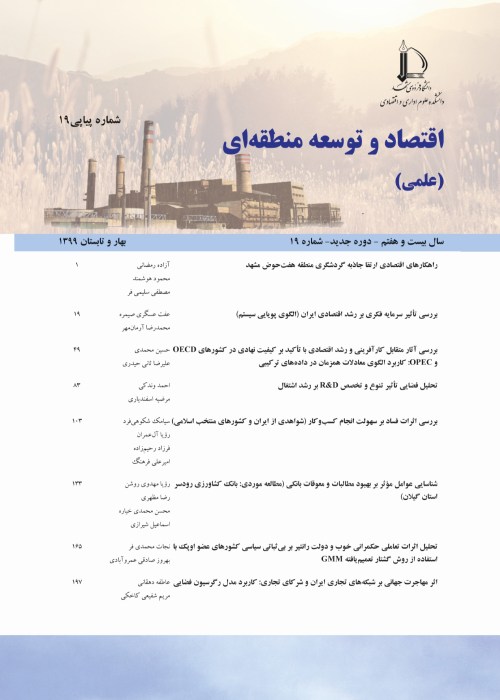The Spatial Spillover Effects of Urbanization on the Convergence of Iranian Provinces (Beta Spatial Convergence)
Economic growth in a country is always one of the important goals and achieving this goal requires growth in all areas related to that economy. Achieving this goal is possible when the competitiveness of the regions increases and its economic performance improves and economic growth in all economic regions tends to a steady trend and becomes so-called convergent. One of the factors that have been considered in recent years as a factor explaining economic growth is the proximity and spatial position of regions. Therefore, the purpose of this article is to investigate the effects of spatial urban spillover on economic growth of the provinces and also the role of urbanization on the rate of convergence of provinces.
One of the important issues in urban economics is how the relationship between urban population growth and economic growth. In this regard, Lefebvre (2009) considered the economic structure and economic growth. According to Bertinley and Black (2004), the channels through which urbanization affects economic growth: First, cities play an important role in the economies and societies of developed and developing countries by providing opportunities for people to benefit from educational, employment and health services in the economic structure of the city.
Second, urbanization allows businesses to take advantage of economies of scale due to externalities, and this makes it possible for companies to specialize and reduce transaction costs. Third, urbanization is a major factor in entrepreneurship. The concentration of population and businesses in cities makes the urban population easily finance their idea and provide the conditions for promoting business ideas and access to local markets with higher consumer density, and ultimately there are spillover effects, these positive external effects of development. Cities in neighboring areas are identified through migration and active interaction. Therefore, according to these theories, there is no separate region and the growth of each region is affected by the growth of the surrounding regions. Thus, despite the effects of urban spillovers, the economic growth of the provinces is converging. In the economic literature, the main idea of convergence is that the lower per capita economy experiences a higher growth rate than the higher per capita economy.
Econometric researchers believe that due to the impact of economic performance of an area on neighboring areas, if the spatial dependence between observations and these effects are not taken into account, the conventional estimation method will be biased and the effect of factors trying to study them will be erroneous. Since the variables used in this study have a spatial aspect and are affected by spatial correlation, and considering that the main purpose of this study is to analyze the role of urbanization in the spatial convergence rate of the provinces, the spatial econometric model is used. Consider each other's observations and the effect of changes in dependent and explanatory variables on neighboring observations. Spatial growth models explicitly include spatial factors in growth models. These models pay more attention to spillovers and seek to find the main drivers of long-term growth in space.
Before estimation of spatial models, to emphasize the need to use spatial patterns in this study, diagnostic tests were performed to estimate the pattern as panel data. As stated in the methodology section, the research model is estimated in three stages. In the first stage, the absolute convergence model is estimated in which there is no urbanization variable. In the second stage, to evaluate the effect of urbanization on convergence and its speed, conditional beta convergence is estimated in terms of urbanization effects, and in the third stage, the space camera model is estimated in terms of urban spatial effects. In absolute beta convergence, it is assumed that the model parameters are the same and the only cause of changes in the economic growth of the provinces are their initial values. Another important point that should be considered before estimation is the spatial effects test that was analyzed in the above sections and therefore the estimation patterns should be estimated in terms of these spatial effects. The results of the first stage estimate show that the sign of convergence coefficient is negative and significant and indicates the existence of absolute beta convergence, i.e., provinces with lower per capita production have faster economic growth than provinces with higher per capita production. Convergence rate is estimated to be 0.0563, This coefficient indicates that about 5.63% of the gap between the initial state of per capita production and the state of equilibrium with its stability is eliminated annually. With the introduction of the urbanization variable into the model, the use of absolute beta convergence is no longer correct because economic growth is also affected by other factors such as urbanization, so in this case conditional beta convergence is raised. In the second stage, the results show that the inclusion of the urbanization variable in the convergence equation leads to a decrease in the estimated coefficient for the initial per capita production variable. In other words, the convergence rate has increased by 1.45% compared to the previous case. The positive effect of urbanization on the convergence of provinces.
Finally, the general convergence hypothesis that other parameters are not constant is investigated and the conditional beta convergence is estimated using the space camera model in terms of other effective variables. The results indicate that in this case, each province has an average rate of 14.29% are moving towards sustainable growth. Therefore, it can be claimed that in terms of direct effects and spatial effects (spillover) of urbanization, the rate of convergence increases.
The purpose of this study is to investigate the economic convergence among the provinces of Iran during the years 2005 to 2017. For this purpose, two types of convergence, absolute beta and conditional beta, were investigated by using spatial growth models. Therefore, first, by performing Moran I test and LM test, the necessity of using spatial models was confirmed. In the present study, in order to better explain the role of urbanization in the rate of convergence of the provinces, the research model was examined in three stages. The results of all models show that the provinces of the country are economically convergent and the existence of absolute and conditional beta convergence between the provinces is confirmed, i.e., less developed provinces have a higher economic growth rate and provinces that are stable from equilibrium. They are more distant; they have a higher economic growth rate. Considering the significance and positive effects of urban spatial spillover, it can be concluded that increasing the interaction and return of citizens to neighboring areas in the provinces due to the effects of the spillover will cause economic growth in neighboring provinces and this will increase the speed of economic convergence.
- حق عضویت دریافتی صرف حمایت از نشریات عضو و نگهداری، تکمیل و توسعه مگیران میشود.
- پرداخت حق اشتراک و دانلود مقالات اجازه بازنشر آن در سایر رسانههای چاپی و دیجیتال را به کاربر نمیدهد.



